Persimmons are a delightful fall fruit that can be enjoyed in various dishes or on their own. However, knowing when a persimmon is ripe can be a bit tricky, as unripe persimmons are inedible and have a bitter taste.
This article will provide valuable information on how to determine the ripeness of a persimmon, so you can enjoy its sweet and delectable flavor at its peak.
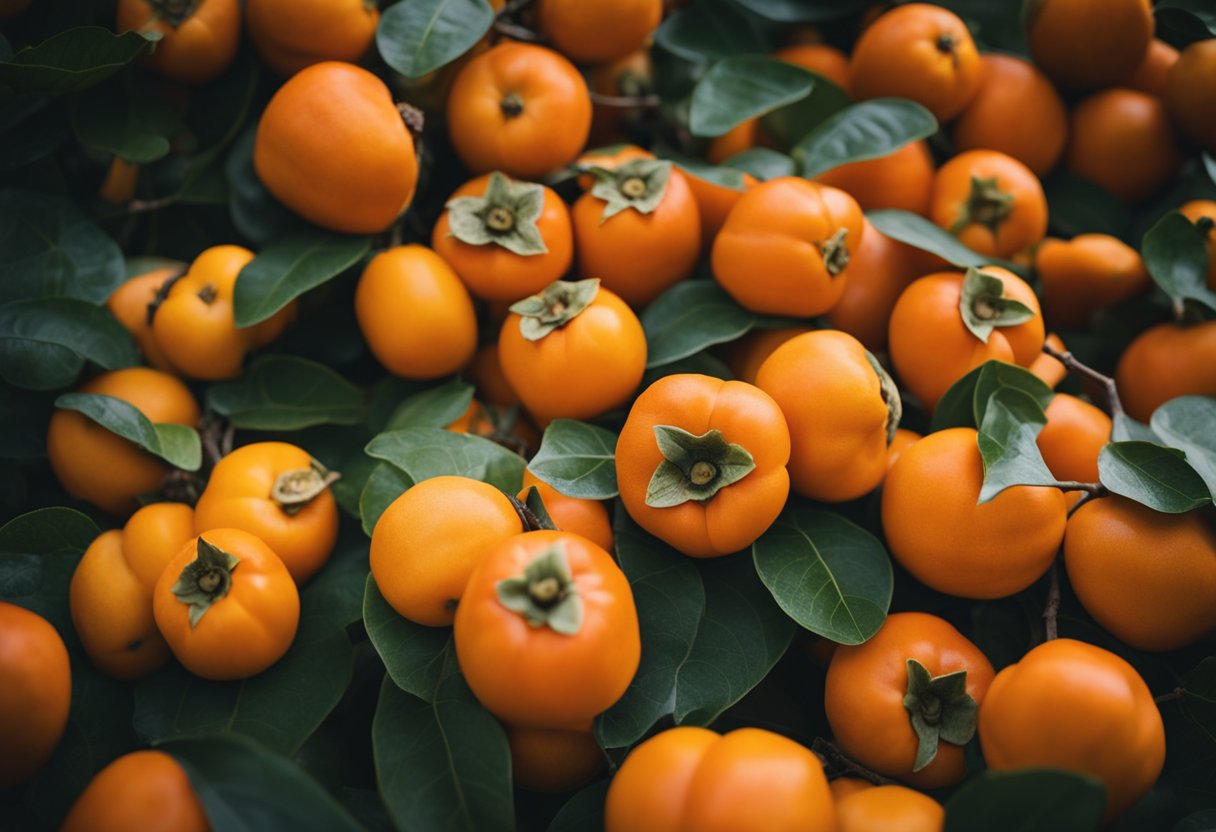
There are two main types of persimmons: Hachiya and Fuyu. Each variety has slightly different indicators to determine ripeness, including color, texture, and smell.
By understanding these signs, you’ll be able to harvest and consume this vibrant fruit at the optimal time, ensuring a satisfying and tasty experience.
Understanding persimmons
Persimmons are a delicious and versatile fruit enjoyed for their sweet and juicy characteristics. There are many varieties of persimmons, which can be grouped into two main types: astringent and non-astringent.
Astringent persimmons, such as the Hachiya variety, contain high levels of tannins and need to be fully ripe before consumption to avoid a bitter taste. To identify a ripe Hachiya persimmon, look for a soft and jelly-like consistency inside.
The fruit should have a bright orange or deep red color, and its texture should yield slightly when gently pressed with a thumb. A ripe persimmon will also emit a sweet, slightly floral aroma.
On the other hand, non-astringent persimmons, like the Fuyu variety, have a lower tannin content, allowing them to be enjoyed when still firm. Fuyu persimmons are also ripe when they display a vibrant, deep orange hue, similar to that of ripe pumpkin; however, they can be eaten while they retain firmness. Gently pressing the persimmon with your thumb will still yield a slight give, indicating ripeness.
In addition to Hachiya and Fuyu, two other common varieties are American persimmons and Oriental persimmons.
American persimmons are native to the United States and are often found in the wild, while Oriental persimmons originated in East Asia. Both American and Oriental persimmons can be astringent or non-astringent and should be checked for ripeness using the same guidelines as the Hachiya and Fuyu varieties.
Knowing the differences between the types and varieties of persimmons is crucial for determining their ripeness and enjoying them at their best. Whether you prefer the creamy sweetness of a ripe Hachiya or the crisp, refreshing taste of a Fuyu, understanding persimmons’ unique characteristics will enhance your appreciation of this delightful fruit.
Related: How to Eat Fuyu Persimmon
Identifying ripe persimmons
When determining the ripeness of persimmons, there are several key factors to consider. One of the most important aspects to look for is the color of the fruit.
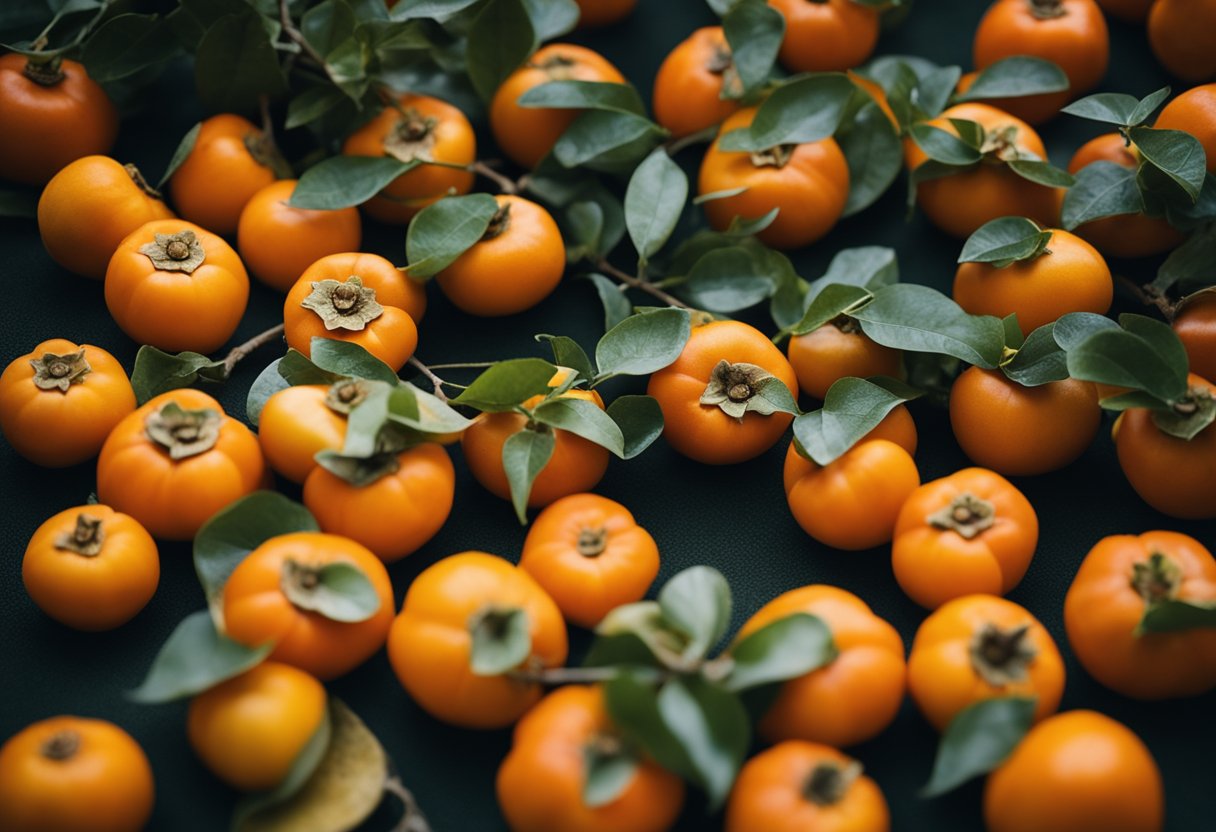
Ripe persimmons typically have a vibrant, deep orange hue, similar to that of a ripe pumpkin. Greenish or faded orange persimmons are likely underripe and should be avoided.
The skin’s appearance is another important indicator of a persimmon’s ripeness. When fully ripe, the skin of the fruit becomes almost translucent, smooth, and free from blemishes. An overripe persimmon may exhibit wrinkling or discoloration, suggesting it has passed its prime for eating.
In addition to color and appearance, texture plays a crucial role in identifying ripe persimmons. A ripe persimmon will have a slight give when pressed gently, much like a ripe tomato.
If the fruit is too hard or too firm, it probably needs more time to ripen. On the other hand, if the persimmon is extremely soft or significantly yields when pressed, it may be overripe and unsuitable for eating.
While assessing the texture, also take note of how the fruit feels in your hand. A ripe persimmon should have a smooth, supple surface, without any rough or uneven spots. This can further indicate that the fruit is at its peak ripeness and ready to be enjoyed.
By considering the color, appearance, and texture of the fruit, one can confidently identify ripe persimmons and enjoy their sweet, succulent taste at its best.
Sensory evaluation of ripe persimmons
Ripe persimmons possess a unique combination of sensory characteristics that make them distinct in the fruit world. Evaluating these attributes is key to determining their ripeness and enjoying their best taste and texture.
The color of a ripe persimmon is one of the most noticeable indicators of ripeness. It generally presents a deep, vibrant orange hue that distinguishes it from its underripe counterparts. The skin of fully ripe persimmons may also achieve a near-translucent appearance.
Texture plays an important role in determining persimmon ripeness. A ripe persimmon should have a slight give when pressed gently, akin to that of a ripe tomato. Overly firm or hard persimmons, on the other hand, are likely still unripe and not yet ready for consumption.
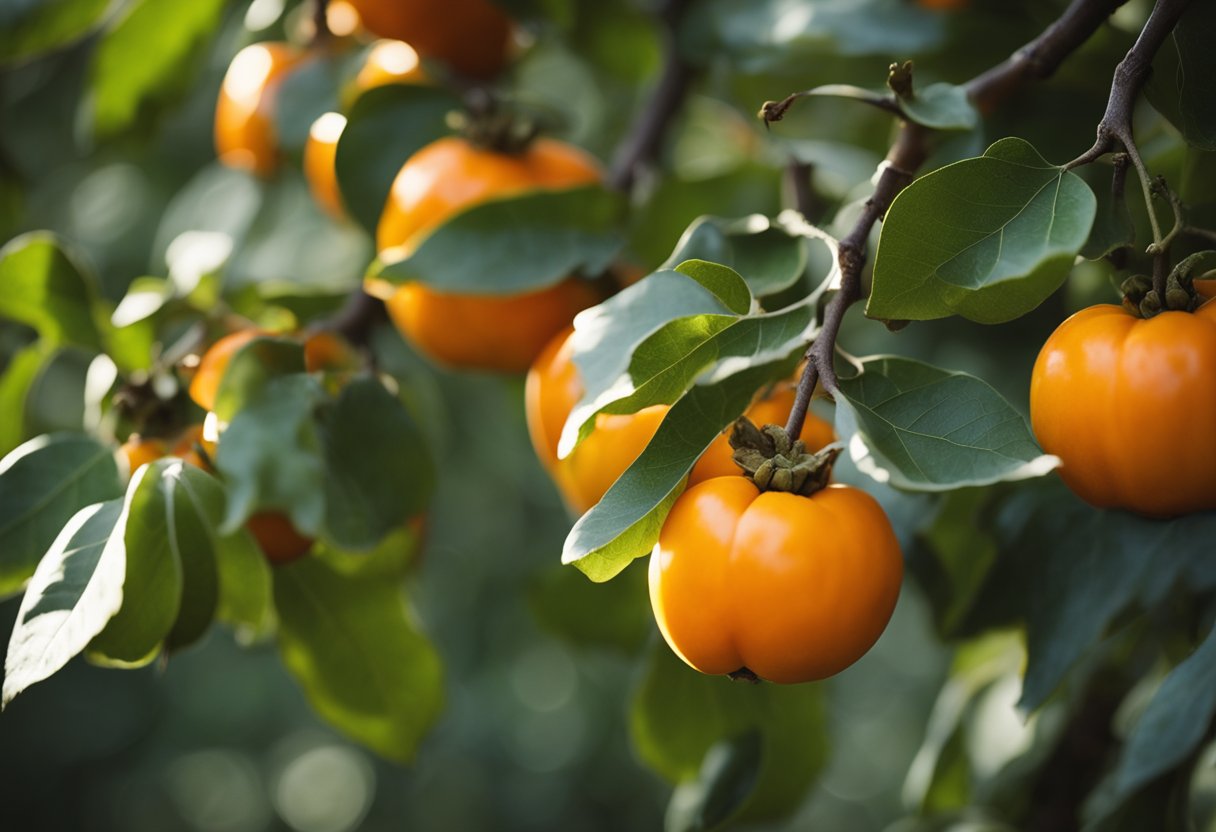
When evaluating the flavor of a persimmon, expect a sweet and rich taste, which is indicative of a fully ripe fruit. Unripe persimmons can be astringent and chalky, causing a bitter or sour sensation in your mouth. Giving a small portion a taste can provide clarity on the ripeness of the fruit.
Lastly, the aroma of a ripe persimmon is another useful sensory cue. As the fruit ripens, it develops a subtle yet distinctive smell that can guide you in your evaluation. A vibrant and pleasing fragrance can signal that the persimmon is at its peak of ripeness, making it an ideal time to enjoy its sweet and flavorful characteristics.
By paying close attention to these sensory indicators, you can confidently determine when a persimmon is ripe and ready to be savored for its delightful taste and texture.
Effects of temperature on ripe persimmons
Temperature plays a crucial role in the ripening process of persimmons. Storing persimmons at optimal temperatures ensures that their quality, taste, and texture are maintained. To achieve the best results, it is crucial to understand the effects of different temperature levels on persimmons.
At room temperature, persimmons continue to ripen steadily. This gentle process allows the fruit’s natural sugars and flavors to develop, providing a more enjoyable eating experience. Placing persimmons in a sunny spot can accelerate the ripening process, but it’s essential to monitor the fruit closely to avoid overripening.
Refrigeration can be used to halt the ripening process and prolong the shelf life of ripe persimmons. Once a persimmon is fully ripe, it can be stored in the refrigerator for up to two weeks.
It is essential to store the fruit in a crisper drawer to maintain optimal humidity levels and prevent the persimmon from drying out. However, it is important to note that refrigerated persimmons should be consumed soon after removal from the fridge, as returning to room temperature can cause them to spoil quickly.
Freezing persimmons is another option for long-term storage. It is vital to wash, peel, and remove any seeds before freezing the fruit.
Persimmons can be stored whole, sliced, or puréed, making them versatile for various recipes. While the texture of frozen persimmon may change slightly upon thawing, the taste remains delicious and satisfying.
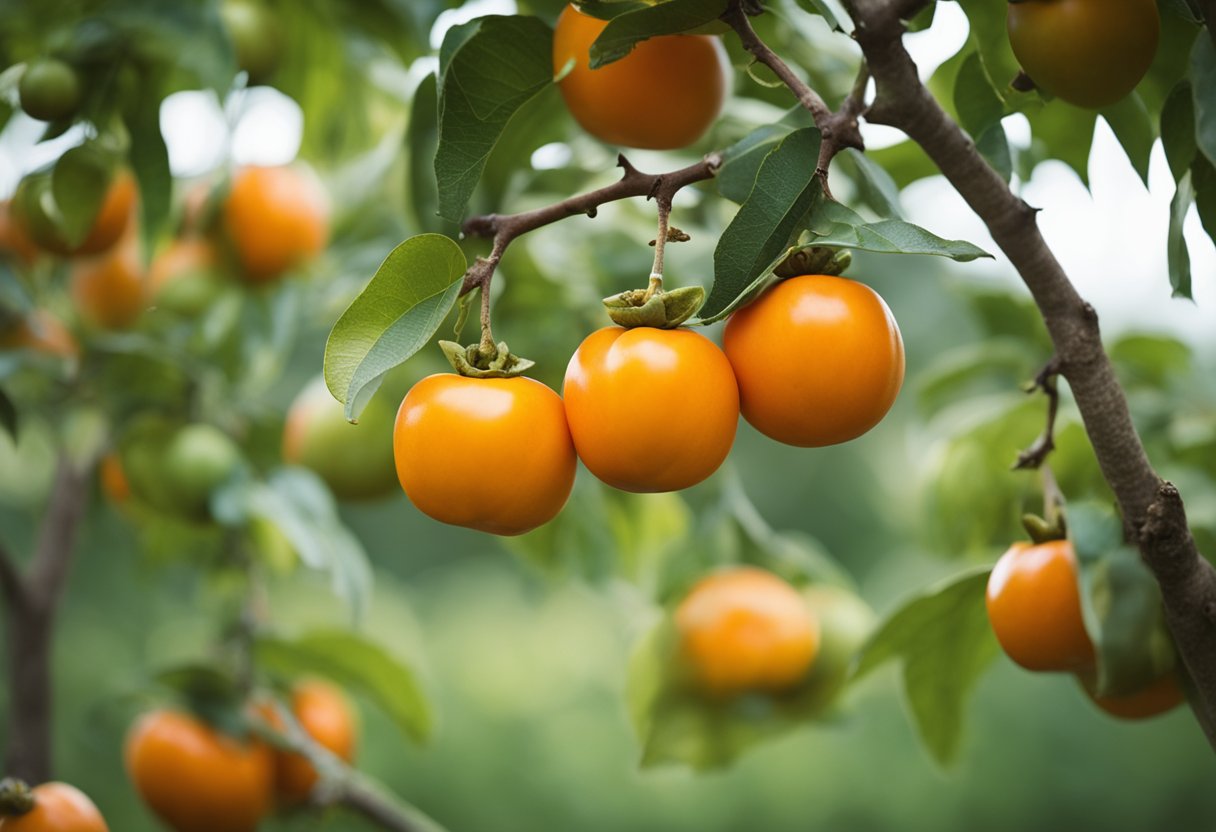
Concerning growing conditions, persimmon trees are known for being cold-hardy and can tolerate a range of temperatures. Most varieties can withstand temperatures as low as 20°F (-6°C), but frost can harm the fruit when it is in a vulnerable stage.
Adequate sunlight is also essential for the proper growth and development of persimmon trees and their fruit. A minimum of six hours of direct sunlight per day is recommended for optimal yields.
Ripening process of persimmons
Persimmons undergo a unique ripening process that heavily depends on the variety of the fruit. The two main types of persimmons are American and Japanese (or Asian) varieties, with each having its own ripening timeline and indicators. It is essential to understand the ripening process to enjoy a persimmon at its peak flavor and texture.
Ethylene gas, a naturally occurring plant hormone, plays a significant role in the ripening process of various fruits, including persimmons. When exposed to ethylene gas, the fruit’s texture transitions from firm to soft, eventually making it ready to eat. For persimmons, this change in softness is a key indicator of ripeness.
The color of the fruit also provides a clue to its ripeness. As persimmons ripen, they take on a deep orange-yellow hue, and their skin becomes almost translucent.
The fruit’s texture, which changes from hard and firm to soft and slightly yielding when gently pressed, is a more reliable way to determine the ripeness of American persimmons1. In contrast, Oriental persimmons can be sweet with various textures depending on the stage of ripeness.
It is crucial to differentiate between an overripe and a rotten persimmon. Wrinkles or dullness on the fruit’s skin may indicate overripeness or be past its prime, whereas rotten fruits may have mold or a foul odor.
Harvesting persimmons should ideally occur when the fruit has attained its mature size and is hard but fully colored2. This is usually between September and October for American persimmons, while Japanese varieties may ripen at different times. Try to prevent the fruit from being picked too early, as raw persimmons have an astringent flavor that results from high levels of soluble tannins.
By understanding and observing the ripening process, softness, firmness, and other characteristics of persimmons, fruit lovers can ensure that they enjoy these delectable fruits at their peak of flavor and avoid overripe, raw, or rotten specimens.
Storing persimmons
Storing persimmons properly is crucial to maximize their shelf life and maintain their delicious taste. When dealing with unripe persimmons, a simple yet effective method to speed up their ripening process is to place them in a paper bag along with a ripe apple or banana. The ethylene gas emitted by these fruits aids in the ripening process, making it easier to enjoy their delectable flavor sooner.
Once the persimmons are ripe, they can be stored in different ways depending on how soon the fruits will be consumed. For short-term storage, ripe persimmons can be placed on the countertop, lasting up to a few days. To extend the shelf life further, refrigerating persimmons is an excellent option, allowing the fruits to remain fresh for up to a month.
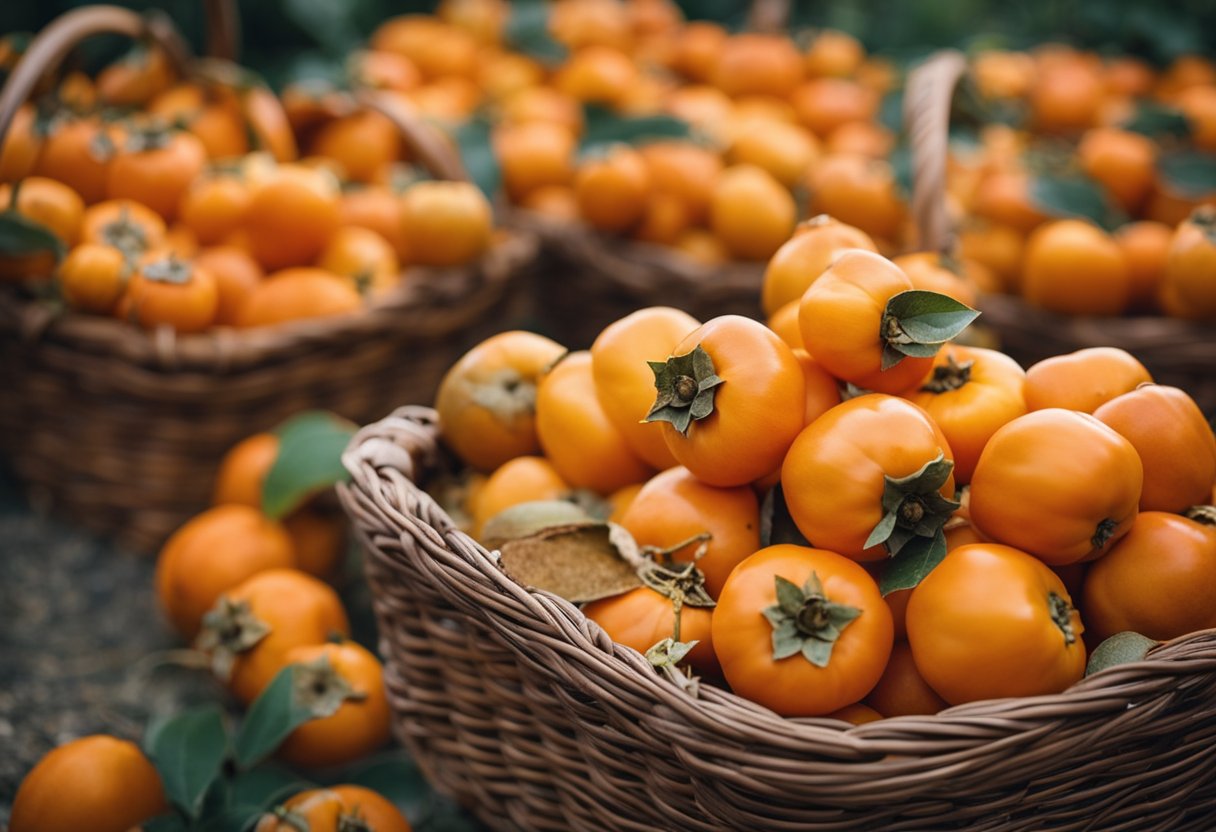
If you anticipate longer storage periods or want to savor the persimmons gradually over time, freezing them is an ideal alternative. Frozen persimmons can last up to eight months, ensuring you have a steady supply of this delightful fruit. Simply remove them from the freezer and thaw them as needed.
In summary, storing persimmons entails placing unripe fruits in a paper bag to hasten ripening, keeping ripe fruits on the countertop for short-term consumption, refrigerating them for up to a month, or freezing them for an extended shelf life of up to eight months. By following these storage techniques, you can confidently enjoy the flavors of persimmons at their peak of ripeness.
Evaluating persimmons by variety
Persimmons come in various varieties, each with unique characteristics that determine their ripeness. In this section, we will discuss the most common types of persimmons – Hachiya, Fuyu, and American persimmon, as well as the differences between astringent and non-astringent persimmons.
Hachiya Persimmons are a popular astringent variety. They are typically oblong or acorn-shaped and have a deep, orange-red color when ripe.
To determine if a Hachiya persimmon is ripe, it should be soft and jelly-like inside1. The skin should appear smooth and slightly glossy. Unripe Hachiya persimmons can be extremely astringent and are not recommended for consumption.
Fuyu Persimmons are a non-astringent variety known for their squat, tomato-like shape. Ripe Fuyu persimmons have a bright orange color and can be eaten when they are slightly firm2.
They have a sweet taste and can be consumed when they are not as soft as Hachiya persimmons. When selecting a ripe Fuyu persimmon, look for a slight give in the texture and a sweet, slightly floral aroma.
American Persimmons (Diospyros virginiana) are native to the eastern United States and are smaller than their Asian counterparts. They can be astringent or non-astringent, depending on the variety3.
Like Hachiya and Fuyu persimmons, ripe American persimmons should have a vibrant orange color and give slightly when gently squeezed. Astringent American persimmons should be soft and slightly gelatinous before consumption, while non-astringent types can be eaten when firmer.
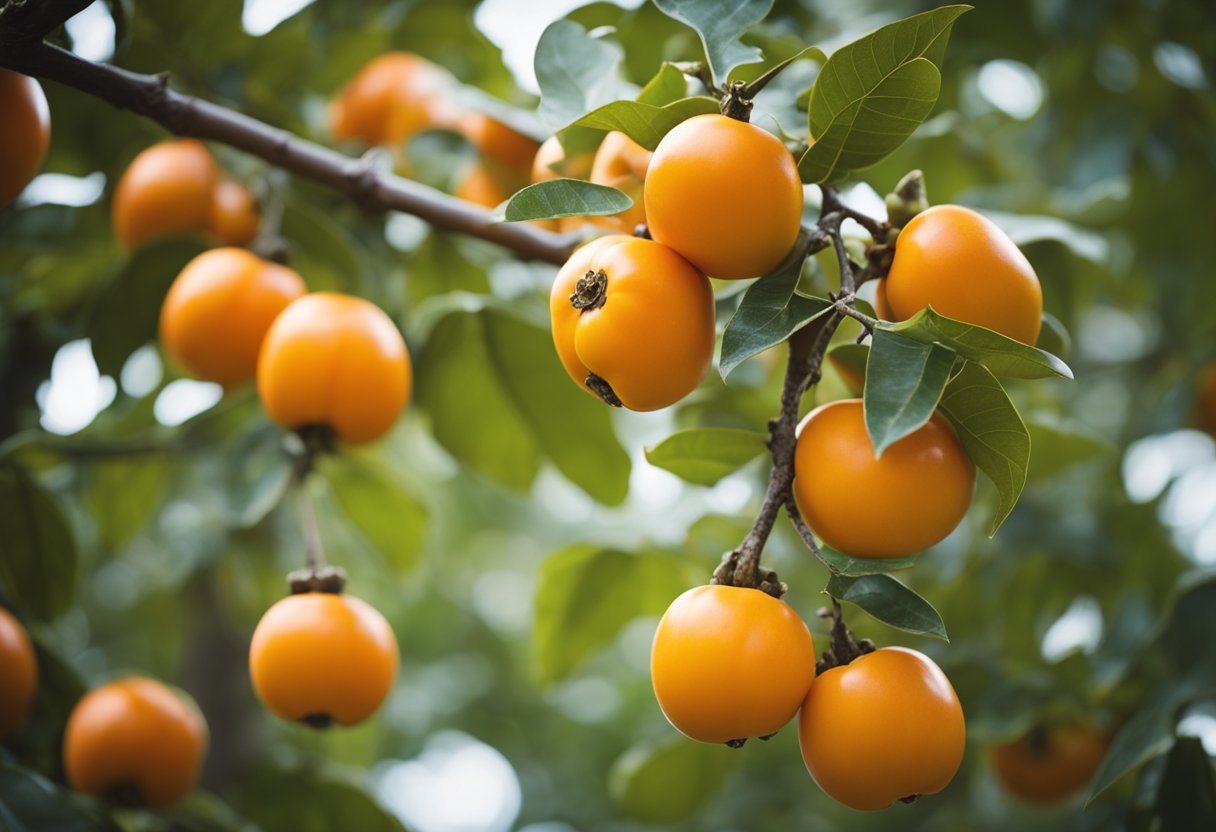
In conclusion, understanding the differences between astringent and non-astringent persimmons is vital for determining their ripeness. Hachiya persimmons are astringent and should be soft before consumption, while Fuyu and many American persimmons are non-astringent and can be eaten when they are less soft. Always evaluate persimmons based on their color, texture, and aroma to ensure you enjoy them at their peak of ripeness.
Uses of ripe persimmons
Ripe persimmons are a versatile fruit that can be enjoyed in numerous ways. Their sweet and unique flavor makes them a popular addition to various recipes, both sweet and savory. Here are some delicious ideas to inspire your culinary creativity with ripe persimmons.
Persimmons can be enjoyed on their own as a refreshing and healthy snack. Simply wash, peel, and slice the ripe fruit for an easy and satisfying treat. You can also add chopped persimmons to fruit salads for a burst of color and natural sweetness.
For sweet indulgences, consider incorporating ripe persimmons into your favorite desserts. They can be added to recipes for cakes, cookies, and puddings, imparting a warm, fruity flavor. In addition, persimmons can be used to make sorbets and ice creams, offering a delightful twist on traditional frozen treats.
If you’re looking to experiment with savory recipes, ripe persimmons make an excellent ingredient for salads. They pair well with roasted duck breast or beef, adding a touch of sweetness that balances the flavors of the dish. Persimmons also work well in grain bowls and rice dishes, providing a sweet contrast to the robust flavors of grains and proteins.
Persimmons can be a fantastic addition to your daily smoothies. Blend them with other fruits, vegetables, and yogurt for a nutrient-packed beverage that’s as tasty as it is healthy. Remember to remove any seeds before blending your persimmons, as they can create an unpleasant texture in the smoothie.
Lastly, don’t forget that ripe persimmons can be used as a natural sweetener. Replace sugar or other sweeteners in your recipes with mashed or pureed persimmons to consume a healthier alternative. This fruity substitution works especially well in baked goods, sauces, and dressings.
So, the next time you come across ripe persimmons, be sure to explore their incredible variety of uses in the kitchen. From fruity salads to indulgent desserts, the possibilities are endless with this delicious and versatile fruit.
Health benefits of persimmons
Persimmons are a nutrient-dense fruit, providing various health benefits due to their rich content of vitamins and minerals. One of the key nutritional components of persimmons is their high level of vitamins A and C. These vitamins play a crucial role in supporting the immune system, maintaining healthy skin, and promoting overall well-being.
Another significant benefit of consuming persimmons is their fiber content. As a fiber-rich food, persimmons can help lower cholesterol levels, regulate blood sugar, and promote a healthy digestive system. In addition to fiber, persimmons also contain other essential nutrients such as potassium, manganese, and antioxidants.
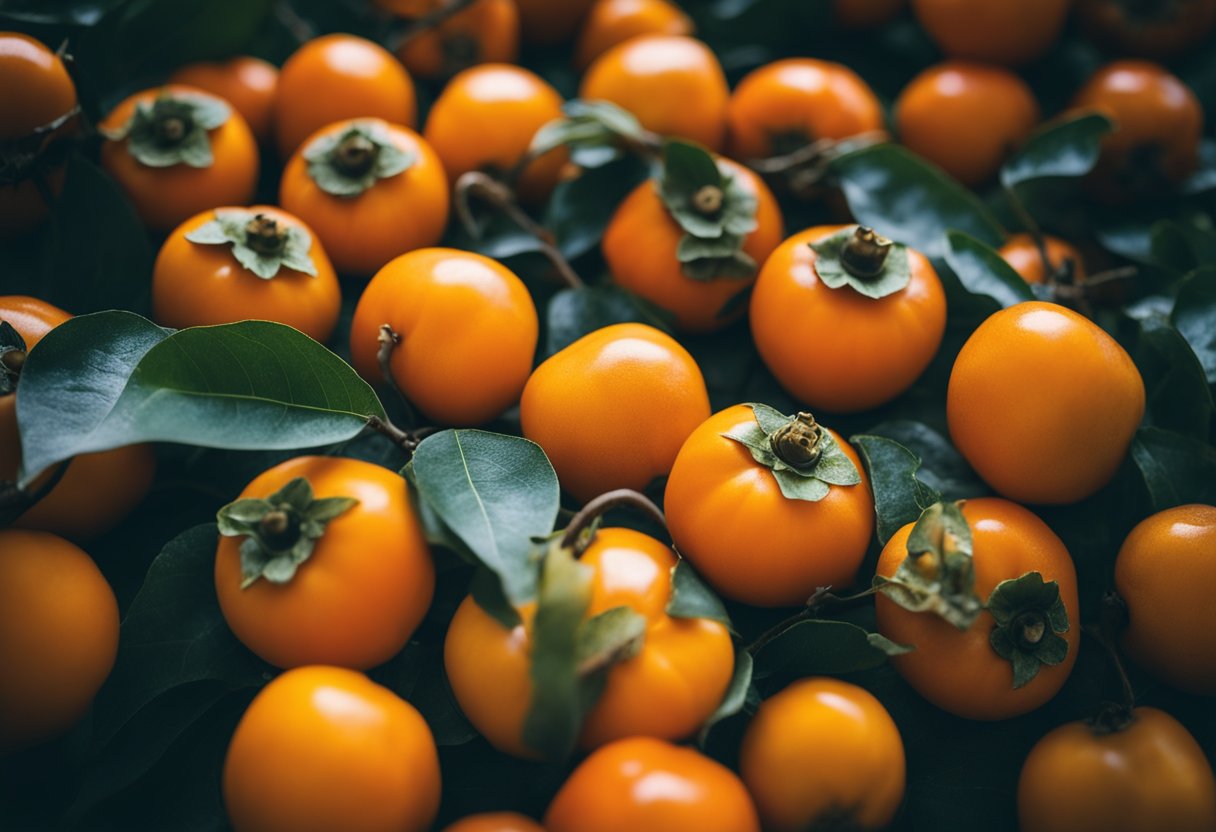
The presence of antioxidants in persimmons contributes to their health benefits, as antioxidants help to neutralize harmful free radicals in the body. This process can protect against cellular damage, which may lead to chronic diseases and aging-related complications.
Here are some notable health benefits of persimmons:
- Rich in vitamins A and C, supporting a healthy immune system and skin health
- High fiber content for improved digestion, better blood sugar control, and lower cholesterol levels
- Good source of antioxidants to protect against cellular damage and support overall health
In conclusion, persimmons are a highly nutritious choice for incorporating into a balanced diet. Their substantial supply of vitamins, minerals, and antioxidants makes them a valuable addition to a healthy lifestyle.
